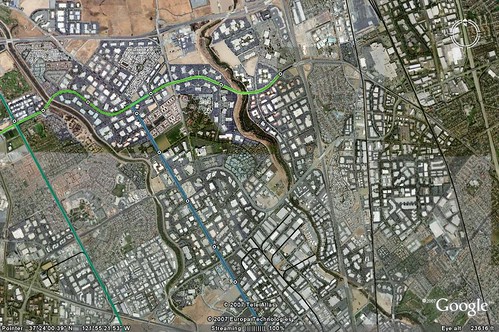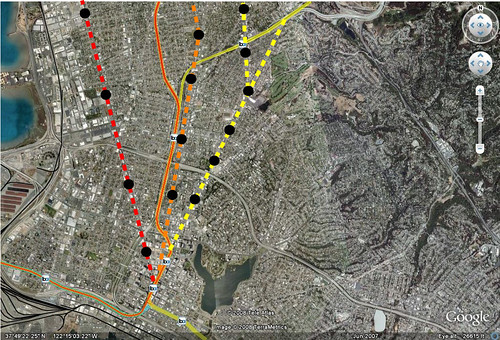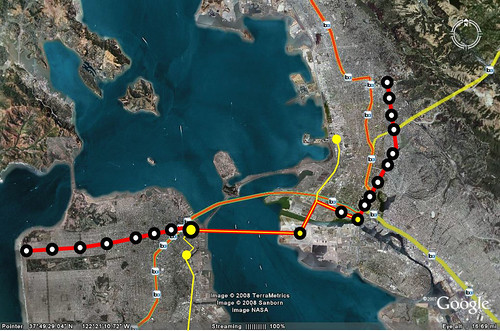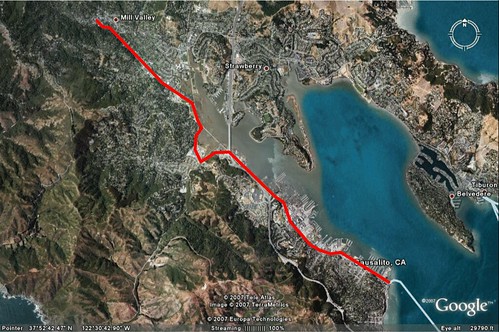Noting that the bike tourists bring cash to the city, the Sausalito business
community expressed concern about making the experience unfriendly for tourists.
"We love the cyclists and tourists that come into town," said Cheryl Popp, Chamber of Commerce president. "Bikes are good for the economy and they are green and clean."
Saturday, March 14, 2009
Quote of the Day
BART Monthly Pass
Tuesday, March 10, 2009
Transit in Trouble - Bay Area Profile
H/T Robert
Sunday, March 1, 2009
Connecting the Dots
Board members used words like "shocked" and "astonished" at the report by consultant Bob Peskin, who analyzed sales tax projections through 2036. Once inflation is factored out, his sales tax projections are essentially a flat line.But if true, this comes at the same time as a SPUR report that states suburban job growth imperils emissions reductions due to increased driving. As a practical goal, the region should focus growth in the more urban downtowns and urban areas that aren't office parks.
The city, and other urban areas better served by mass transit than suburban business parks, must adjust policies to attract a greater share of office development and employers, concludes "Recentering Work: The Future of Transit-Oriented Jobs in Downtown San Francisco," released by the San Francisco Planning and Urban Research Association.So while the BART extension to downtown San Jose might seem like a good idea, its important to note that the round about way in which BART reaches downtown doesn't connect the areas which hold most of Silicon Valley's jobs but rather takes the path of least resistance (ie: existing ROW).
This is a big problem. The line which was conceived many years ago is a continuation of BART and regional authorities poor planning for rapid transit integration with land use. While it might have been state of the art as an idea decades ago, we've learned so much since then about TOD and how connecting destinations strengthens them. No longer will the suburban to urban model work with parking lots catering to the automobile. We need a better analysis of what to do but unfortunately it seems like nothing will stop this move from going through.
The map below shows job density in the valley (From LEHD 2004). Areas with the darkest green are over 20 jobs per acre. But the new BART line (dark blue) touches only the clusters downtown and extension of the VTA light rail line (light purple) go nowhere near the jobs that would attract transit riders.
 The VTA Light Rail line hits a lot of the dense job clusters but underperforms because it is seen as slower. I don't know how many people who live in San Francisco have told me that the killer for thier connection to a job in San Jose is the slow round about light rail. This will be the same excuse for BART to light rail on the other side of the Valley.
The VTA Light Rail line hits a lot of the dense job clusters but underperforms because it is seen as slower. I don't know how many people who live in San Francisco have told me that the killer for thier connection to a job in San Jose is the slow round about light rail. This will be the same excuse for BART to light rail on the other side of the Valley.
When we look into these long term Bay Area projects, we need to push planners to think about where people work and where they want to go. It's really important to think about these long term strategies to connect people with jobs and connect jobs to each other. If we're going to be dependent on a knowledge economy here in the bay area, allowing people easy access through transit to amenities and each other is the best way to facilitate energy and emissions reductions. Even if TOD springs up along the new BART line, it won't be as good as connecting the existing clusters of dense jobs with tons of redevelopable parking spaces (see above photo) that might not be needed with rapid transit easily accessible.
Tuesday, February 17, 2009
Practice What You Preach
Friday, November 14, 2008
Friday Night Linkfest
~~~~~~~~~~
Looks like the FTA finally got around to saying they would fund the University Link.
~~~~~~~~~~
Stimulus for California HSR?
~~~~~~~~~~
The Capricious Commuter is back. It's not Erik, but its good to have another newspaper blogging local transportation.
~~~~~~~~~~
It looks as if Washington Metro is off the hook... for now.
~~~~~~~~~~
David Goldberg argues that the old economy of autocentricty could be over. According to a recent study in Australia written in part by the super awesome Peter Newman, $85 million dollars in up front infrastructure costs are being wasted per every 1000 housing units built on the fringe. With the $250 million in transport costs that could be saved as well, thats a lot of money thrown away.
Sunday, June 22, 2008
Arlington Did It Right
It got me thinking, what would BART look like if they had made the decision to build like Metro in DC and run the line through main corridors instead of down the center of the freeway. Here is what I came up with. The dotted lines and black dots I drew and the regular line and existing stations are shown by the little BART symbols.
If I were to speculate that these stations would have the ridership of 24th and 16th street mission, we would be seeing an additional 110,000 riders.

Since BART didn't learn anything from Arlington either, the BART to San Jose line will make the same mistakes, running on existing ROW instead of down the main corridors where its needed. The same exists with the BART to Livermore extension which we discussed earlier.
Monday, June 9, 2008
Assorted Bay Area News
Whoa Muni. Looking at the ridership statistics on light rail from this last quarter, more people are definitely riding the rails. 173,000 a day is pretty good I would say. Although it sounds weirdly high. The Transit Effectiveness Project when taking ridership accounted for 157,424.
Also, if you're interested in the Livermore BART extension, there will be a public meeting Wednesday June 18th in Livermore at 6pm. I'm thinking I might show up, given that I'm on that side of the Bay on Wednesday evenings. Here's a post we wrote a while back on it.
More info:
Robert Livermore Community Center, Larkspur Room
4444 East Ave.
Livermore, CA 94550
The website to view the alignments is at www.barttolivermore.org
Their contact info is:
Phone: (510) 464-6151
E-mail: info@barttolivermore.org
H/T to Joel for the email.
Thursday, June 5, 2008
Not that Simple
I worry about analysis like these in the Tyee. While it's nice to think that if we didn't build that heavy rail line we could build x more miles of streetcar lines, it's really not that simple. Mostly because they serve two different purposes. You can't just say we can have 8 miles of streetcar for a mile of heavy rail, because what is happening is your trading short trips at a slower speed for longer trips at a faster speed. It's necessary to have both.
This morning I was listening to forum on KQED and one of the callers said it was absurd that he couldn't get from Sunnyvale to Berkeley in 2 hours. This is due to the lack of express trains between major destinations. In a better transit system, you would have Caltrain bullets stopping only at places like San Jose, Palo Alto, and San Francisco. Then it would go in it's own tube to Oakland and Berkeley. This is an expensive service due to the tube and electrification etc, and would likely generate calls to spend money more "cost effectively". They would say, why not build 400 buses or the next big trade off. The problem is you need both. In order to make transit useful, there need to be short trips and long trips made easy.
Now I know there is limited funding, but we need to start thinking like non-transit wonks think. And they think, why can't I get from a to b in under an hour if it takes that long in my car. Transit has to be competitive time wise, whether you're trying to hop a few blocks to get a bite to eat or going to a different city in the region.
Saturday, May 24, 2008
Giving Transit Expansion to Those Who Plan For It
One day after the city's transit committee agreed to support the much-discussed Transit Option Four, they added a special note for any suburban constituents or councillors hoping for expansion of the light rail tracks outside the Greenbelt: you'll have to prove that it's a worthy investment by demonstrating greater demand and higher population density.The only place in the United States I can think of that has this type of rule is the Bay Area and the Metropolitan Transportation Commission. The MTC is the local MPO and they have set up a system that mandates certain densities for cities to get funding for new transit expansion. And cities take it seriously. A Contra Costa Times article yesterday discusses transit officials in Antioch that are worried they won't make their intensity benchmark if they leave the station in the place for which its planned.
The median location near Hillcrest Avenue would constrain transit-oriented development because of the existing PG&E property, thus making it difficult to reach a Metropolitan Transportation Commission mandate for residential units within a half mile radius of a station, city planning officials said.I wish more MPOs were as progressive as the MTC. Most of them are just highway money distributors. Here is their policy summed up:
Each transit extension project funded in Resolution 3434 must plan for a minimum number of housing units along the corridor. These corridor-level thresholds vary by mode of transit, with more capital-intensive modes requiring higher numbers of housing units.Now that residential units are down, there needs to be a jobs policy, because as we noted in a post on jobs, its great to have residential density, but unless it connects to where you want to go, it doesn't really help much.
Wednesday, May 7, 2008
The Tragedy of California
The thing you really forget about the deplorable land use and development patterns in southern California (and the Southwest more generally) until you come back out here is how goddamn nice the weather is, a fact that takes the situation out of the realm of farce and into tragedy. You know what a good place to never walk anywhere would be? Boston or Chicago in the winter. Or maybe DC or New York in the summer. That's some nasty weather to be walking around in.
But LA would be a great place to walk or ride a bike to work all year 'round. But it's our bad weather belt that has the walkable cities, and our sunny and temperate all the time region that barely has sidewalks.
Friday, January 25, 2008
Calculating the Taxpayer's Real Expense
My favorite comment, "We all, collectively and for the most part unwittingly, agreed to approve and finance that funding package." We only seem to complain when gas prices get a little higher.So if we consider that, in 2005, the most recent year for which I have stats at arm’s length, Bay Area motorists drove nearly 58 billion miles, at AAA’s average U.S. operating cost of 52 cents a mile, that’s $30.2 billion to add to our transportation funding formula, and that still doesn’t include the purchase price of new cars.
That’s like a once-in-a-generation statewide transportation bond measure, but just for the Bay Area. We all, collectively and for the most part unwittingly, agreed to approve and finance that funding package.
So here’s the new math: $3 billion a year for transit, including fares paid by individual commuters, and $31.9 billion a year for the streets, roads and vehicles that operate upon them. That would be 8.5 percent of the Bay Area’s transportation spending.
Sunday, January 13, 2008
Thinking Big: The Next Bay Area Project
But that isn't what i really wanted to talk about. I have a new idea for the Bay Area's newest New Start/Transit Project. I'd like to call it the Subway to the Sea 2, Urban Core Capacity Enhancement. The title is a nod to the Subway to the Sea bubbling up in LA and the New Jersey Access to the Core tunnel under the Hudson. If we're going to densify the bay area further, we need more of a metro system along major corridors. We need to be cost effective, so we should start with a corridor that would generate a lot of new ridership. So how about we build a line between the beach and downtown on Geary, build the new trans-bay tube that's been planned, and build up Broadway in Oakland to Rockridge and Berkeley under the 51 line.
Current ridership in this corridor is 56,000 for Geary and 18,600 boardings on the 51. This means that if everyone changed modes (which we know there still has to be a surface bus line for shorter trips) there could be about 80,000 riders. Given the speed of the new line and convenience it could increase ridership to way over 100,000 a day just on the line. This is a third of BART's ridership. Now the line is 19 miles from Berkeley to the Sea along the route I mentioned.
Now the line wouldn't just generate a lot of ridership, but it would generate a lot of new TOD, Office and Residential. In Oakland on Broadway, there would be a surge in new development along the corridor between College Avenue and Downtown. It's possible to capture a lot of the office and residential markets and take some pressure off of the outer sprawling suburbs. It will also take pressure off of the almost at capacity Transbay Tube.
Another feature of this would be the tunnel under the bay. it should be designed to be dual mode so that Caltrain/HSR could go to Oakland, Emeryville, and/or Jack London Square. That way Caltrain could extend into downtown and across the bay to Emeryville and possibly beyond making a connection between the jobs there and Silicon Valley (Yellow). It's possible to electrify the line all the way up to Martinez making commutes from around the horn easier with new stations in North Richmond and Hercules. It might also provide a way to keep trains away from Jack London which has had some issues with accidents. It would be a big project and more than likely cost a lot of money, but it will also be a huge ridership generator. Not only will you get over 100,000 from the subway alone, there will be the tens of thousands that want to get across the bay with a one seat ride to Emeryville and Jack London Square.

Tuesday, December 11, 2007
Transit & Acupuncture
So now I had to get to the acupuncturist in Montclaire. I left an hour before the appointment as the 59 comes every hour from Lake Merritt BART. I sat in the back of a 30 foot VanHool bus and watched the really nice houses pass by on the hills. It was actually a nice ride if not a little bumpy. But there was a catch. My appointment was going to be over at 5 but the last 59 went to the Rockridge BART at 4:15 or so. Not good. So I had to figure out a way back. Well where the 59 dropped off the 18 picked up and I was lucky enough that it ran every 15 minutes into the evening. So when I was done at 5 I hopped on the 18 and traveled on the other side of the hill from the 59. It took me to the 12th Street BART station and I hopped on the 24th street and mission turn around train to go home since I wouldn't be going to my Gramma's house.
I was thinking a bit negatively that there wasn't a 59 but my roommate pointed out that we are lucky to live in a fairly transit friendly place in the bay area and the fact that there was an 18 at all was good. It was still at 15 minute headways so yes, that was pretty good. I imagine that if I were in Houston or somewhere else this wouldn't have worked. So my car died, but i knew that I could depend on transit to get me where I needed to go. It took a little more time, but I got to watch the world go by instead of having to slog through traffic.
Wednesday, November 14, 2007
Sausalito Streetcar?
Two architects in Sausalito are proposing a streetcar system to Mill Valley. According to the Marin Independent Journal:
They also have gotten the attention of elected leaders in Southern Marin, who say the trolley plan could work. Money, of course, will largely determine whether the trolley system ever becomes reality. Rex and Nichol envision a trolley that would run on tracks built into existing roads and flow with traffic. They would be powered by a single overhead electric wire.I've created a map of the route. In terms of TOD and Redevelopment, it doesn't seem like a bad one. The only problem I see is that this is a heavily traveled route by car with sections prone to auto backups. Since this is a main route, it doesn't seem wise to be in the street. There is however sufficient space in the median in many places. It also allows people who live in Mill Valley and Sausalito to get to the ferry to San Francisco fairly easily without a car and is actually close to most of the developed area. Take a look below.They figure it would cost $20 million to $50 million to get a demonstration line up and running from the Depot in Mill Valley to ferry terminal in Sausalito in five years. Trolleys would stop every quarter or half mile along Miller Avenue and then Bridgeway. Trolleys eventually could serve Novato, San Rafael, Fairfax, San Anselmo, Ross and Tiburon.

